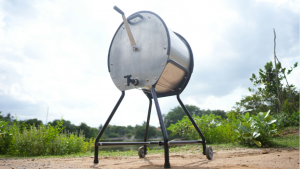
Adding solar panels to existing buildings is a costly, labour intensive process but that may be about to change. Having spent the past 16 years using the income from their furniture business to fund their research into flexible solar panels, a father-son duo from Los Angeles, California have developed a new, ultra-thin solar powered wallpaper that they claim can stick to just about any surface.
Len and Philip Gao are the pair behind Sunflare, a solar energy company that has successfully produced the world’s first solar “wallpaper”. Using their patented Capture4 solar technology, they are able to harness a cell-by-cell manufacturing process that does away with the glass substrate found in most solar cells, allowing for an enormous degree of elasticity.
Made with copper, gallium, indium and selenide, the solar cells developed by Sunflare are said to be superior to traditional solar technologies in terms of efficiency and weight. Weighing 65 per cent less than standard solar panels and able to generate up to 10 per cent more power, the wallpaper represents an enormous breakthrough for the industry.
“No company had ever cracked the code on manufacturing copper indium gallium selenide solar cells to accomplish consistent, high quality, mass produced solar panels,” Len Gao told Sustainable Brands. “But our team solved those issues.”
The thin-film, solar wallpaper offers users a simple installation to everything from vehicles to buildings. According to Gao, they can be secured to any surface using only a special, double-sided tape. The wallpaper is even flexible enough to conform to the varied curves of multiple appliances, allowing for its application on everyday items.
Producing more energy at dawn and dusk because of better low light performance, and at midday when temperatures are hottest because of the low temperature co-efficient of CIGS, the Sunflare manufacturing process also is environmentally cleaner, Gao claimed. This is because it takes less energy to manufacture, it doesn’t use toxic chemicals, and it uses less water.
“Unlike silicon panels, our panels do not need space under it for cooling,” Gao said. “Crystalline silicon panels get hot as the sun gets hotter and, ironically, doesn’t work as well when it is hot. Sunflare solar panels have a lower temperature coefficient and, therefore, do not have those issues.”
Although not yet available for direct purchase, the product could potentially cost as little as $1, 77 per watt. Sunflare envisions the wallpaper eventually being utilised on a global scale and in industries as varied as military, construction and automotive.






